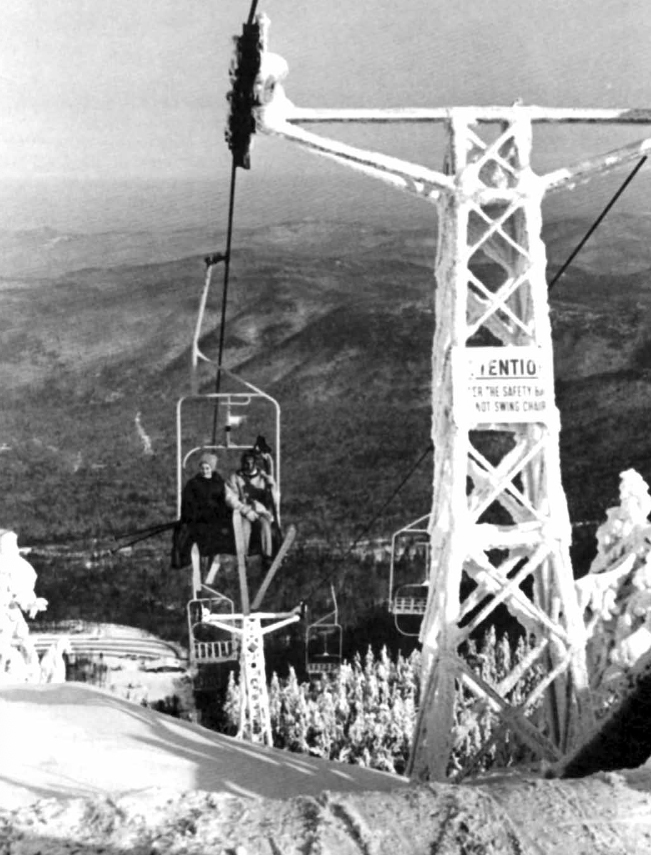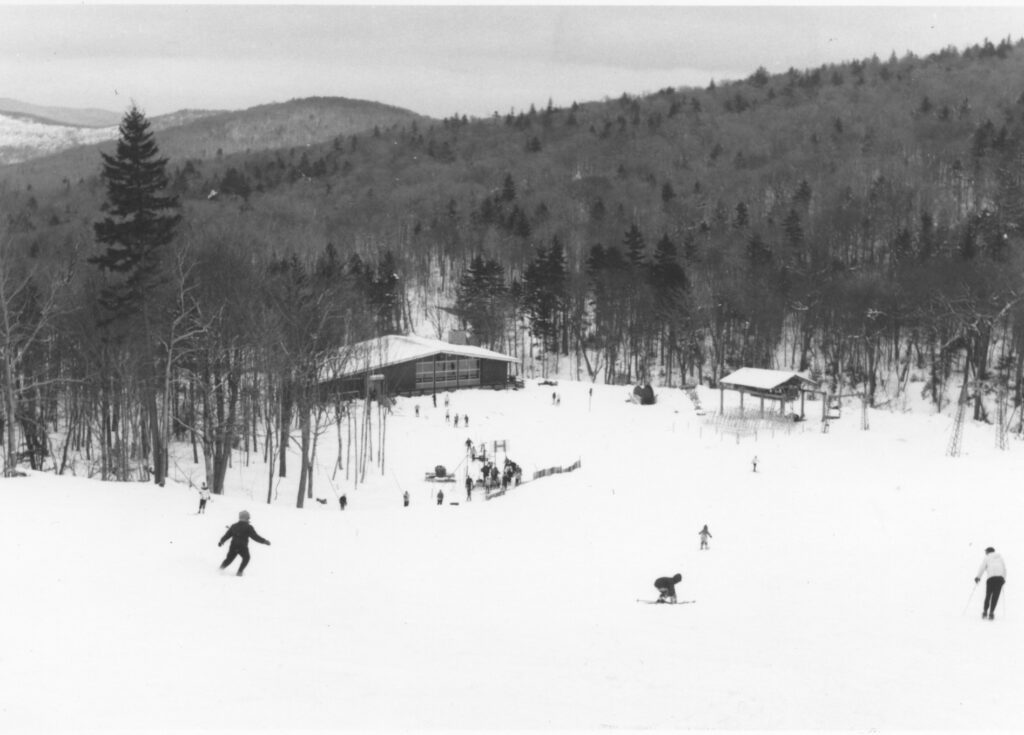Snow, summer, and snowshed: 1960 saw fast progress
How Killington became The Beast: Part 9
By Karen D. Lorentz
Editor’s Note: This is the ninth segment of an 11-part series on the factors that enabled Killington to become The Beast of the East. Quotations are from author interviews in the 1980s for the book “Killington, A Story of Mountains and Men.”
The Vermont Forest & Parks Dept. had been unable to complete a base lodge in time for Killington’s debut in 1958, but in 1959, they erected a modern two-story Killington Base Lodge, which surpassed expectations. (Killington expanded it several times over the years before replacing it with today’s spectacular K-1 Lodge.)
The summer of 1959 saw mountain progress with crews carving two trails off Killington Peak — the steep Cascade trail and the easier Goat Path (now Great Northern), which meandered over to the Glades (now North Ridge) and allowed lower ability-level skiers to utilize the new chair and pursue a longer route to the base. The Great Bear Trail was built on Snowdon, and the novice area by the base lodge was expanded.
Preparation for the first chairlift included cutting the lift line and installing foundations for the lattice towers. However, Killington’s first chairlift was delivered late, which resulted in a challenging installation due to early snowfall.
A tough first chair install

Skiers ride an original K chair with lattice towers.
“It was a 6,300-foot-long chairlift and the first chairlift I’d ever built. We were doing things on a shoestring and had elected to build the chair with our own crew. It was a learning process, from learning how to read blueprints to building all the footings and putting all the pieces together. We did pretty well, except I don’t think I did an excellent job planning the time. We plugged along,” recalled Pres Smith of a trying time.
“Cold weather came, and we still weren’t done,” he continued. “Then it snowed; we were almost done, but then it snowed and snowed. We were still aligning the towers, and there were 5 to 6 feet of snow on the ground, and we had to dig down for each of the four legs on the lattice towers. It was prolonged and difficult.”
“We ended up getting that lift into operation in March [1960]! I realized then that we had to do things differently,” Smith added.
Ironically, before it could prove itself for winter ski operations, the Killington Double Chair inaugurated summer business, carrying almost 5,000 visitors to the historic peak between late June and October.
Sue Smith noted that when they originally researched starting a ski area, summer business levels in the White Mountains of New Hampshire led them to believe Killington could be a four-season resort and that summer revenues would contribute significantly to total operating revenues. Envisioned as a year-round resort, the 1960 summer operation of the chairlift marked the first attempt to attract summer and fall foliage season business.
Billed as the East’s highest chairlift (which it was before Beech Mountain was developed in North Carolina in the 1970s) the aerial lift brought sightseers to the 4,200-foot elevation, where they could enjoy spectacular views or take a short hike to the 4,241-foot rocky pinnacle for more views. Plans were to run the chair year-round with the exception of May and November, which at the time were non-ski months!
With the Killington chair operating for its first full winter 1960-61 and the trails greatly expanded and improved, the ski area caught the eye of ski clubs, colleges, and racers. So, although the 1960–61 season was a recession year for the ski industry in New England, Killington enjoyed a successful and record third season. Gross revenues were up 58% to $218,000, and net income rose to $9,837 as attendance jumped from 39,804 to 64,850, and the season extended from December 14 to May 8 for 145 days of operation. Only one other area in Vermont reported an increase in attendance that year.
A focus on beginners
Original development plans had called for an aerial lift or Pomalift to be built to the top of 3,800-foot Skye Peak, the third mountain area, but due to the wind conditions there, serious doubts had arisen as to its feasibility.
At the same time, Smith could foresee the phenomenal 1960s growth of the sport and was interested in catering to beginners and new skiers. A decision was made to install a lift on the lower portion of Skye Peak, where the terrain was previously thought to be too flat to appeal to skiers!
A Pomagalski and Cie three-quarter-mile long double chairlift was ordered from France. However, when they received the engineering profile, the company thought a mistake had been made as the slope seemed too shallow. “They had never received an order for a chairlift to be built on such a flat hill,” Smith noted.
This idea to cater to beginners with what was considered at the time to be very flat terrain was unheard of in the ski industry and was deemed “tremendously risky. It was scary because we didn’t know it would fly,” recalled Operations Manager Paul Bousquet.
A major lift and skiing area just for beginners was considered heresy as most beginner terrain at that time was steeper than Snowshed or smaller in size and utilized surface lifts. (The ¾-mile-long Snowshed slope has a gradient ranging between 6% and 15%, while Snowdon averaged 24%.)
But Smith thought that Snowshed’s gentle terrain would make an ideal, separate learning area and an appropriate place for ski school classes.
Having learned a valuable timing lesson with the Killington chair, crews began clearing a 3,600-foot liftline on Snowshed on May 22, 1961. Two gradual trails, Snowshed (a narrow trail under the lift) and nearby Yodeler, were cut.
A connector trail, Highland [later renamed Highlander] was built to Killington Basin where a much smaller beginner area had been built by the base lodge. The original Idler trail brought skiers back to the Snowshed Area, which had increased the overall vertical of the ski area to 2,000 feet. A new Snowshed parking lot was built by the Vermont Forests & Parks Dept., and a rustic, temporary base shelter was built by the company.
A second 600-foot novice Pomalift, a Model “D” specially designed to be a gentle, slow riding lift for children, was also added to the novice slope above the Killington Base Lodge, bringing the area’s total to two double chairs and five Pomas with a total capacity of over 4,600 skiers per hour. Investment in the mountain by the Sherburne Corporation, banks, and the State of Vermont had reached almost $1 million.
Next week, we’ll explore how Killington’s ability to grow eventually made it known as The Beast of the East. Comments and insights are welcome: email [email protected] to share thoughts about skiing in the 1950s.

The first Killington beginner area situated above the K base lodge with baby Poma to left and new chair to right, circa 1960.




